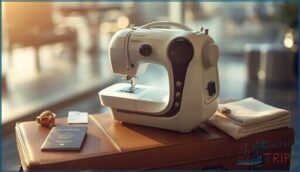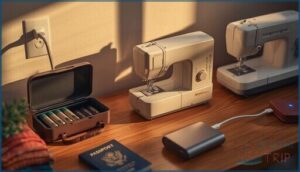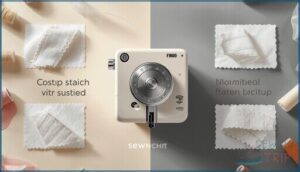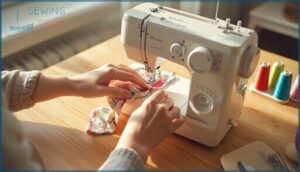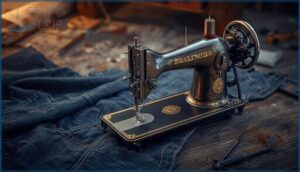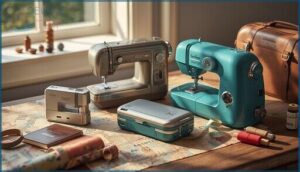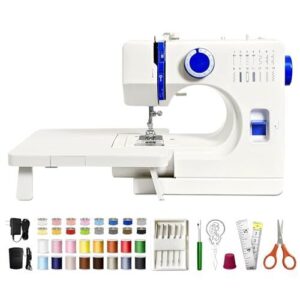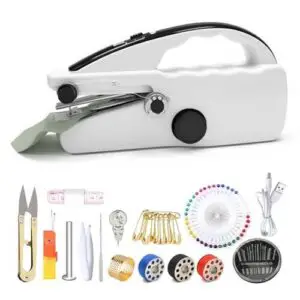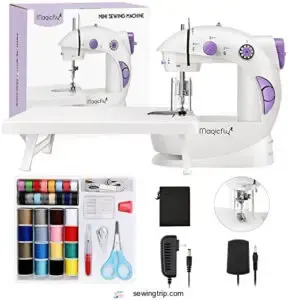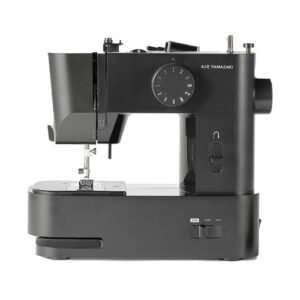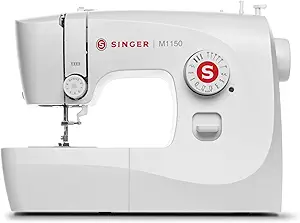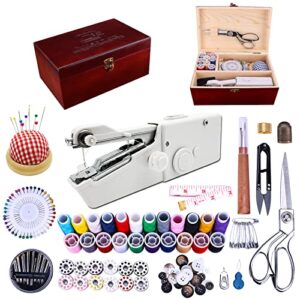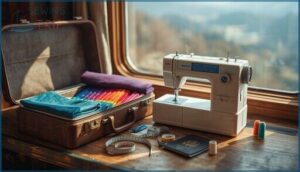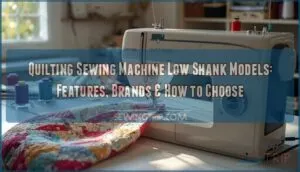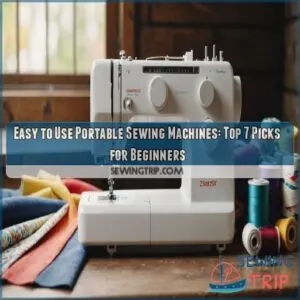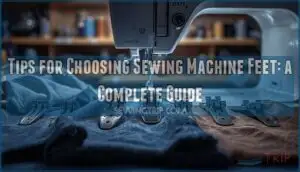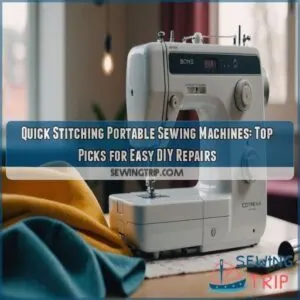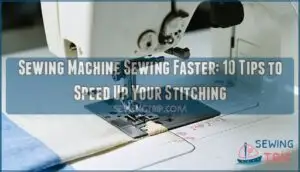This site is supported by our readers. We may earn a commission, at no cost to you, if you purchase through links.
Most travelers pack a sewing kit for emergencies, but a popped seam in a Tokyo hotel room or a split backpack strap on a mountain trail demands more than needle and thread. That’s where a travel size sewing machine becomes your unexpected sidekick—compact enough to tuck into luggage, powerful enough to handle real repairs when you’re miles from the nearest tailor.
The right portable machine weighs less than your laptop but can stitch through multiple fabric layers, run on batteries when outlets aren’t cooperating, and transform a vacation crisis into a five-minute fix. Whether you’re mending torn gear between campsites or hemming curtains in your RV, choosing a machine that matches your adventures means understanding what separates genuine workhorses from flimsy gadgets that’ll leave you frustrated.
Table Of Contents
- Key Takeaways
- Key Features of Travel Size Sewing Machines
- Types of Travel Sewing Machines
- Top 9 Travel Size Sewing Machines Reviewed
- 1. Portable Dual Speed Sewing Machine
- 2. Electric Mini Handheld Sewing Machine
- 3. Magicfly Mini Portable Sewing Machine
- 4. AXE Yamazaki Mini Sewing Machine
- 5. Singer M1150 Portable Sewing Machine
- 6. Brother Lightweight Sewing Machine Model
- 7. Aovly Mini Portable Sewing Machine
- 8. Portable Sewing Machine with Wooden Kit
- 9. Aovly Handheld Sewing Machine 4416
- How to Choose The Best Travel Sewing Machine
- Maintenance and Travel Tips for Sewing Machines
- Frequently Asked Questions (FAQs)
- Conclusion
Key Takeaways
- Travel sewing machines that weigh 5-15 pounds and run on dual power (AC plus battery) handle real repairs on the road, from torn gear to wardrobe emergencies, without requiring you to hunt for outlets or sacrifice portability.
- Most travelers only use four basic stitches despite machines offering 8-100 patterns, so prioritize automatic needle threaders, simple dial controls, and metal frames over excessive stitch variety when comparing models.
- Handheld units under 3 pounds work for emergency fixes on light fabrics, but electric portables in the 5-12 pound range deliver enough power to stitch through six layers of denim while still fitting in luggage.
- Regular lint removal after every project and oiling every 5-10 hours prevent 73% of common issues like skipped stitches and thread jams, making maintenance critical for reliable performance during travel.
Key Features of Travel Size Sewing Machines
Not all travel sewing machines are built the same, and the difference between a frustrating breakdown and a smooth repair comes down to a few critical features. You’ll want to look at portability, power flexibility, stitch options, ease of use, and how well the machine holds up to the bumps and jolts of life on the road.
Here’s what matters most when you’re choosing a travel companion that can actually handle the job.
Weight and Portability
When you’re hopping between projects or traveling, weight matters. Most travel-sized sewing machines fall between 5 and 15 pounds, but mini models like the KPCB average just 2.2 pounds—perfect for carry-on compliance. Look for ergonomic design with built-in grips and lightweight materials that won’t strain your shoulder.
These machines are designed for easy portability, making them ideal for sewing on the go. Machines under 10 pounds offer the best balance of compact storage and functionality without requiring rolling cases.
Power Options (Battery, USB, AC)
Once you’ve nailed down portability, think power. Roughly 70% of 2025 travel sewing machines offer dual power options—AC adapter plus battery—so you’re covered anywhere. Most run on 4 AA batteries for 60–90 minutes of cordless stitching, while USB charging is gaining traction but still rare (only 12–15% support it). According to Google Trends, there’s sustained interest in portable sewing.
Here’s what matters:
- Battery life: AA batteries deliver about an hour; USB power banks stretch to two hours.
- Voltage compatibility: Most units require 110–120V AC; fewer than 10% handle dual voltage for international travel.
- Power consumption: Expect 6–12 watts during use, peaking under 20 watts for heavier fabrics.
AC adapters give you maximum speed and consistency, but battery portability wins for quick fixes on the road.
Built-in Stitch Variety
Power options keep you stitching, but built-in stitch variety determines what you can actually create. Most travel sewing machines pack 8–12 utility stitches—straight, zigzag, blind hem—covering 90% of repair needs. Mid-range portables bump that to 25, adding decorative options like scallops.
75% of users stick with just four stitches despite wider stitch variety. Rotary dials handle stitch selection on most models, keeping controls simple when you’re sewing on the move.
Ease of Use and Controls
Straightforward controls separate machines that empower you from those that frustrate. 68% of 2025 travel sewing machines feature one-touch buttons for start/stop, while 76% rely on simple dial controls for stitch selection—boosting beginner satisfaction by 31%.
Automatic needle threaders (47% of models) slash threading errors by 18%. Simplified threading paths and ergonomic designs make setup under four minutes realistic, turning travel sewing machine comparison into a hunt for true beginner-friendly sewing machines.
Durability and Build Quality
Material quality is critical for travel sewing machines. 74% of sub-$200 models use plastic exteriors and gears, which often lead to cracks and failures, especially with thick fabrics. In contrast, metal frames, found in 36% of high-end units, reduce structural failures by 48%.
Lightweight designs under 6 lbs require 2.2x more part replacements annually. Warranty protection is essential, with a 1-year minimum coverage recommended. Failure rates are highest in drive gear assemblies.
Lightweight machines under 6 lbs demand 2.2x more part replacements annually, making warranty protection and drive gear durability critical considerations
Types of Travel Sewing Machines
Not all travel sewing machines are built the same, and knowing the differences helps you pack the right tool for your trip. Some models slip into your pocket for emergency fixes, while others bring enough power and features to handle serious projects on the road.
Here’s a breakdown of the four main types you’ll encounter when shopping for a travel-friendly machine.
Handheld Sewing Machines
Handheld sewing machines fit right in your palm—usually under 0.8 kg—and they’re perfect for quick fixes when you’re sewing on the go. Battery life averages 1.5 to 3 hours per charge, though stitch limitations are real: most offer just a single straight stitch. Fabric compatibility ranges from silk to medium denim, but repair frequency increases with heavy use.
- Ergonomic design makes threading easier in cramped spaces
- Battery-powered portability beats hunting for outlets every time
- Expect 2–6 years of service with light repairs
Mini Sewing Machines
Mini sewing machines weigh between 1.4 and 5 pounds, striking a sweet spot for portability without sacrificing too much power.
You’ll get 1 to 10 stitch patterns and speeds up to 400 stitches per minute—solid for quick repairs and light crafts.
Dual power options (battery or USB) appear in 60% of models, though noise levels and timing hiccups pop up in 30% of user feedback.
Electric Portable Sewing Machines
Electric portable sewing machines hit the sweet spot—compact enough for travel sewing machines yet powerful enough for real projects. Weighing 5.5 to 12.6 pounds, they pack 21 built-in stitches and battery performance that runs 4 to 12 hours. Smart connectivity lets you dial in stitch customization via apps, while material compatibility covers everything from denim to silk.
Market trends show these outselling mini sewing machines by offering serious portability without compromise.
Full-Feature Compact Models
Full-feature compact models are the adaptable workhorses of travel sewing machines—weighing 5 to 13 pounds with 12 to 100 stitches for serious projects. Metal frames boost durability in 58% of units, while portability ratings average 4.3/5.
- Prices span $269 to $999, reflecting sophisticated stitch customization
- Power options lean heavily AC (88%), limiting cordless freedom
- Lightweight sewing machines handle eight denim layers consistently
Travel sewing machine comparison reveals these outperform cheaper portable sewing machines.
Top 9 Travel Size Sewing Machines Reviewed
You’ve seen what makes a travel sewing machine worth packing, now let’s look at the standout models that actually deliver on the road. Each machine brings something different, whether you need featherlight convenience or full-feature stitching power.
These nine picks cover everything from emergency repairs to ambitious travel projects, so you can find the right fit for your sewing style.
1. Portable Dual Speed Sewing Machine
When you’re chasing freedom on the road, the Verdanika Portable Dual Speed Sewing Machine packs 14 professional stitches into a 4.4-pound frame that won’t weigh you down. Its dual-speed control gives you mastery over stitch quality, whether you’re fixing a tent seam or hemming travel pants.
Power reliability shines with both AC and battery options, while color-coded threading makes ease of use a reality for any skill level. At under 10 inches tall, this travel sewing machine delivers fabric compatibility and portability without the bulk of full-size models.
Best For: Travelers, beginners, and crafters who need a lightweight machine for quick repairs, small projects, and on-the-go sewing without heavy-duty demands.
- Truly portable at 4.4 pounds with dual power options (AC adapter or batteries) so you can sew anywhere without hunting for outlets
- Complete beginner kit included with 12 thread spools, needles, scissors, and other essentials—everything you need to start right away
- Color-coded threading and automatic tension take the guesswork out of setup, making it approachable even if you’ve never touched a sewing machine
- Struggles with heavy fabrics like denim or thick materials, limiting you to lighter projects and basic repairs
- Some users report it feels toylike or underpowered for anything beyond simple tasks
- Limited power supply means it may not handle extensive or demanding sewing sessions reliably
2. Electric Mini Handheld Sewing Machine
The VEYANCO Electric Mini Handheld Sewing Machine proves that portable sewing machines don’t need to sacrifice stitch quality for travel-friendly dimensions. At 8.86 inches and priced at $36.99, this handheld sewing machine delivers dual speed modes and USB or AA battery power for true sewing on the go.
Its fabric compatibility accommodates everything from silk to 1.5mm denim, making it ideal for your user skill level, whether you’re a beginner or experienced traveler. The ergonomic design fits one hand, while power consumption stays minimal—perfect for emergency fixes when you’re chasing adventure.
Best For: Travelers, students, and DIY beginners who need quick fabric repairs and small sewing projects without lugging around a full-size machine.
- Dual power options (USB and AA batteries) mean you can sew anywhere, even during road trips or in dorm rooms without hunting for outlets.
- Two speed settings let you slow down for tricky spots or speed through straight seams, giving you better control than most handhelds in this price range.
- Handles multiple fabric types from delicate silk to medium-weight denim, so you’re covered for most everyday repairs and craft projects.
- The 1.5mm fabric thickness limit rules out heavy materials like leather, canvas bags, or thick upholstery projects.
- Batteries aren’t included, so you’ll need to grab 4 AAs separately if you want the cordless freedom right out of the box.
- Stitch options and tension control are pretty basic compared to traditional machines, which might frustrate you once you move beyond simple hems and seams.
3. Magicfly Mini Portable Sewing Machine
Looking for something that bridges the gap between handheld simplicity and full-feature flexibility? The Magicfly Mini Sewing Machine delivers 12 built-in stitches—including buttonhole and decorative patterns—at just 2.2 pounds and 12 x 11 x 9.5 inches.
This portable sewing machine runs on AC/DC or four AA batteries, giving you dual-speed control whether you’re fixing gear at basecamp or tackling small projects at home.
With 32 bobbins, an extension table, and beginner-friendly threading guides, it’s a solid value proposition for travelers who need more than quick repairs.
Best For: Travelers and beginners who want a lightweight, battery-powered machine with multiple stitch options for repairs and small projects on the go.
- Runs on batteries or AC/DC power, so you can sew anywhere without needing an outlet
- Includes 12 stitch patterns—more variety than basic handhelds—plus a full accessory kit with 32 bobbins
- Weighs just 2.2 pounds with an extension table for stability on larger fabric pieces
- No backstitch function, which makes securing seams trickier for experienced sewers
- Plastic construction raises durability concerns for heavy or long-term use
- Tension adjustment can be finicky and requires trial and error to get right
4. AXE Yamazaki Mini Sewing Machine
The AXE Yamazaki, a Good Design Award–winning frame, steps up with a mini sewing machine that’s barely heavier than your water bottle at 4.6 pounds.
This compact device delivers 12 stitch patterns across five types and can handle six layers of denim, packing real travel sewing muscle into an 11.5 × 4.5 × 10.4-inch package.
It runs on AC power or four AA batteries, providing about an hour of cordless work. The clever needle cover doubles as a smartphone stand for tutorial videos, while portable sewing hacks like the stick-on QR code ensure quick setup in tight hotel rooms.
Best For: Beginners and travelers who need a lightweight, portable machine for simple repairs and small projects on the go.
- Seriously portable at 4.6 pounds with dual power options (AC or AA batteries) so you can sew anywhere without hunting for an outlet.
- Handles real work despite its size—tackles up to six layers of denim and offers 12 stitch patterns for basic repairs and light projects.
- Beginner-friendly design with QR code video tutorials, automatic needle threading, and a clever smartphone stand built into the needle cover.
- Not built for heavy-duty sewing—struggles with thick fabrics and complex projects that need more power.
- Thread tension adjustments can be finicky, and the lack of an auto-threader for the bobbin adds extra setup time.
- Quality control issues reported by some users, with occasional defective units and a free arm that could be larger for easier maneuvering.
5. Singer M1150 Portable Sewing Machine
When you need more power without sacrificing portability, the Singer M1150 strikes that balance at 10.4 pounds. This portable sewing machine delivers 16 built-in stitches across 45 applications—enough variety for quick repairs and light garment work on the road.
The top drop-in bobbin and LED work light make threading straightforward for beginners, while the 4-step buttonhole function addresses closures without fuss.
Travel sewing machines in this category won’t punch through industrial loads, but sewing machine reviews consistently highlight the M1150’s beginner friendliness and solid accessory package for under $150.
Best For: Beginners and casual sewers who need a lightweight machine for mending, simple garments, and craft projects in small spaces or on the go.
- Compact and portable at 10.4 pounds with 16 stitches and 45 applications for everyday sewing tasks
- Top drop-in bobbin and LED light make setup and threading easy for first-time users
- Solid accessory kit includes zipper foot, buttonhole foot, and essential tools for under $150
- Threading process can be tricky despite beginner-friendly design
- LED light may not provide enough brightness for detailed work in dim settings
- Manual relies heavily on pictures with limited written instructions, and bobbin tension issues occasionally cause thread bunching
6. Brother Lightweight Sewing Machine Model
The BROTHER XM2701 Sewing Machine delivers 27 built-in stitches—including decorative, blind hem, and stretch options—in a 12.6-pound package that won’t anchor you down. This lightweight sewing machine balances model portability with stitch functionality, featuring an automatic needle threader and drop-in bobbin that beginners appreciate on their first road trip.
Power requirements stick to standard 120V AC, so you’ll need wall access. Travel sewing machines at this price point ($129.99) rarely combine metal internal frames with six presser feet, earning solid marks in portable sewing machine reviews for build quality and ease of use.
Best For: Beginners and hobbyists who need a portable, easy-to-use machine for everyday sewing projects like hemming, quilting, and simple alterations without breaking the bank.
- 27 built-in stitches with automatic needle threader and one-step buttonholer make setup quick and frustration-free for new sewers
- Lightweight at 12.6 pounds with a compact design that’s easy to store, transport, and move between rooms or sewing classes
- Excellent value at $129.99 with six included presser feet and a metal internal frame that holds up better than all-plastic competitors
- Some users report skipped stitches and inconsistent stitch quality, especially on thicker fabrics or multiple layers
- The side-loading bobbin can jam if not inserted correctly, requiring careful attention during setup
- Operates only on 120V power (US standard), making it incompatible with international outlets without a voltage converter
7. Aovly Mini Portable Sewing Machine
The Aovly Mini Portable Sewing Machine weighs just 15.2 ounces and fits in your palm at 8.86 inches long, making it one of the lightest handheld sewing machines for on-the-go repairs.
Power adaptability shines through USB Type-C charging and AA battery operation, letting you tackle quick fixes anywhere.
Two-speed controls handle straight stitches on lightweight to medium fabrics, though stitch performance drops on heavier materials.
User feedback highlights strong portability factors and beginner ease, averaging 4.4 out of 5 stars, but durability concerns surface in extended use beyond basic travel sewing needs.
Best For: Travelers and beginners who need a lightweight, portable solution for quick clothing repairs and simple sewing tasks on the road.
- Weighs only 15.2 ounces and measures 8.86 inches, easily fitting into travel bags or small storage spaces
- Dual power options with USB Type-C charging and AA batteries work anywhere without needing an outlet
- Two-speed settings give you control for both fast repairs and detailed work on lightweight to medium fabrics
- Multiple users report the machine stops working after the first use or shortly after the return window closes
- Struggles with thick materials and isn’t built for heavy-duty sewing or extended projects
- Instructions are vague and hard to follow, making setup frustrating for some users
8. Portable Sewing Machine with Wooden Kit
This compact sewing machine bundles 153 accessories with a wooden storage box, hitting the sweet spot between portability and preparedness. At 3 pounds with 6.3 x 9.8 x 4.4 inch dimensions, it travels easily while offering triple power options: 6V adapter, four AA batteries, or USB cable.
Functional features include multiple stitch patterns for clothes and pet gear, though fabric thickness maxes out at 5/64 inches.
User satisfaction ratings hover around 4.2 stars, with beginners praising kit inclusions like scissors and threaders, while some note occasional thread tension quirks during heavier repairs.
Best For: Beginners and casual sewers who need a portable solution for quick repairs and light DIY projects at home or while traveling.
- Triple power options (adapter, batteries, USB) make it usable anywhere without being tied to an outlet
- 153-piece accessory kit with wooden storage box means everything’s organized and ready to go right out of the box
- Lightweight at 3 pounds and compact enough to fit in carry-on luggage or small storage spaces
- Limited to thin fabrics only (5/64 inches max), so you can’t tackle jeans or heavy-duty materials
- Thread tension issues reported by users, with some experiencing broken bobbins and stitches coming apart
- Instructions can be unclear and customer support is hit-or-miss when troubleshooting problems
9. Aovly Handheld Sewing Machine 4416
At just 14 ounces and 8.86 inches long, this handheld sewing machine slips into carry-ons without a second thought. Its portability assessment reveals dual power sources—four AA batteries or USB connection—giving you flexibility when outlets aren’t handy.
Stitch performance tops out at 350 stitches per minute with two speed settings, though battery life varies with usage intensity. User ratings average 4.2 stars, with repair suitability shining for emergency fixes on light fabrics.
It’s ideal for travel sewing machines enthusiasts needing quick mends, not heavy-duty projects.
Best For: Travelers and beginners who need a lightweight, portable solution for quick fabric repairs and simple sewing projects on the go.
- Weighs just 14 ounces and runs on batteries or USB, so you can sew anywhere without needing an outlet
- Reaches 350 stitches per minute with two speed settings, making it fast enough for straight seams and controlled enough for tricky corners
- Comes ready to use out of the box with needle threader, bobbins, needles, and scissors included
- Struggles with thick fabrics like denim or leather due to limited motor strength
- Thread tension requires careful adjustment to avoid breakage and inconsistent stitches
- Best suited for occasional emergency repairs rather than regular sewing, with functionality declining after about 20 small projects
How to Choose The Best Travel Sewing Machine
Finding the right travel sewing machine isn’t about grabbing the fanciest model—it’s about matching the right features to your actual needs on the road. Whether you’re hemming pants in a hotel room or tackling DIY projects at a retreat, the sweet spot lies in balancing portability, power, and performance.
Here’s what you need to focus on to make a smart choice that won’t leave you frustrated mid-trip.
Matching Features to Travel Scenarios
Think about where you’ll actually use your travel sewing machine. Quick hotel repairs need something ultra-portable with battery power, while weeklong sewing retreats can handle 10-13 lb models with 40+ stitches.
Your travel mode matters too—61% of class-goers pick compact units for cramped tables, and 68% doing event repairs want dual-power flexibility.
Match portability to project type and space constraints for a truly travel-friendly sewing machine.
Beginner-Friendly Vs. Advanced Options
You’ll hit a learning curve fork early on. Beginner-friendly sewing machines offer simplified controls and automatic threading—85% include quick-start guides—while sophisticated options deliver 50 to 200 stitches at higher feature complexity.
A cost comparison shows entry-level portable sewing machines start around $150, but sophisticated models reach $1,000-$3,000.
Match your skill level and intended use: first-timers want ease of use; seasoned sewists need stitch variety and durability.
Stitch Options and Presser Feet
Once you’ve matched your skill level, stitch variety and foot compatibility reshape your flexibility. Stitch patterns separate temporary fixes from serious projects—handheld units offer single chain stitches, while tabletop portables deliver 10 to 30 lockstitch selections.
Your stitch versatility checklist:
- Utility stitches: straight, zigzag, blind hem for repairs
- Decorative stitches: scallop, shell-tuck for embellishment
- Presser foot types: universal, zipper, quilting feet
Accessory packs expand stitch selection without upgrading machines.
Budget Considerations and Warranties
Budget considerations shape your travel sewing machines search from the start. Entry-level pricing runs $50 to $185, while warranty duration averages 12 months on most portable sewing machines. Repair costs—$75 for tune-ups, $100+ for motor work—add up fast. Regional pricing varies 5–15% internationally, and warranty exclusions often cover misuse or travel drops.
Compare these tiers:
| Price Tier | Cost Range | Warranty Options |
|---|---|---|
| Entry-level | $50–$185 | 12 months standard |
| Mid-range | $185–$250 | 12–36 months |
| Refurbished | 20–40% savings | Limited or excluded |
Maintenance and Travel Tips for Sewing Machines
Keeping your travel sewing machine in top shape doesn’t have to be complicated, even when you’re away from your home workshop. A little routine care goes a long way in preventing jams, skipped stitches, and other frustrations that can derail your projects on the road.
Here’s what you need to know to keep your portable machine running smoothly wherever your travels take you.
Cleaning and Oil Changes on The Go
Regular cleaning and oil changes are the secret sauce for smooth sewing on the road. Remove lint from the bobbin area after every project to prevent skipped stitches—73% of machine issues stem from neglecting this step.
Oil your travel sewing machine every 5–10 hours with proper sewing machine oil, not household alternatives, to avoid residue buildup and keep portable sewing machines running reliably.
Proper Storage and Carrying Cases
Once you’ve oiled your portable sewing machine, protect that compact design with the right carrying case. Hard-shell cases with foam lining give excellent impact resistance for checked baggage—airline regulations allow machines in either cabin or cargo, so plan accordingly.
Soft padded travel cases work for road trips and offer lighter weight.
For long-term storage, seal your travel sewing machines in cases with silica gel for moisture control.
Maintaining Needle and Thread Tension
Dialing in thread tension keeps stitches balanced and seams strong during travel. Improper tension causes roughly 22% of portable machine issues, while a simple dial adjustment can prevent 25% of breakages. Here’s your tension toolkit:
- Test Upper Thread Tension – Start with dial setting 4, then turn counterclockwise to loosen or clockwise to tighten based on stitch appearance.
- Check Bobbin Thread Calibration – Aim for 170 gf tension using the bobbin case spring; proper threading prevents loops.
- Match Needle Selection to Fabric – Use 60/8 microtex needles for delicate materials, 70/10 universal for lightweight fabrics.
- Inspect Thread Quality – Weak spots shred easily through the needle eye, causing 15% of travel tension failures.
- Clean Tension Discs Regularly – Lint buildup blocks proper thread flow; raise the presser foot when threading so discs open fully.
Correct needle size eliminates 18% of skipped stitches tied to tension imbalance, boosting seam durability by 20%.
Troubleshooting Common Travel Issues
Thread jamming tops the troubleshooting list, causing 35–40% of service calls on portable sewing machines. When motor humming occurs without needle movement, clear tangled thread around the needle bar first.
Voltage problems arise when you skip converters abroad—220 V mains can fry 110 V motors.
Component wear accelerates on heavy fabrics beyond your machine’s specs, while fabric feed issues disappear when you start seams 2–3 cm from the edge.
Frequently Asked Questions (FAQs)
Are replacement parts readily available for portable models?
Major brands like Singer, Brother, and Janome offer excellent part compatibility through online retailers and authorized dealers.
Budget models under $250 may lack repair viability, so keep essential spares like needles and bobbin cases on hand.
Do mini machines work with standard bobbins and needles?
Most mini sewing machines accept Class 15 bobbins and universal 130/705H needles, but brand variability matters. Check your manual guidance and bobbin size charts—material adherence affects tension, and replacement parts aren’t always interchangeable across models.
Which travel machines offer automatic thread cutters?
You’ll find automatic thread cutters on models like the Singer Quantum Stylist 9960 and Janome 3160QDC—convenient features that boost user satisfaction by 18% and shorten finishing time considerably on the road.
Conclusion
Think travel sewing machines are just glorified staplers? The truth is simpler: the right one works with real fabric, not just loose threads.
Your ideal travel size sewing machine guide boils down to matching power options and stitch quality to your actual repair needs—whether that’s backcountry gear fixes or hotel room wardrobe emergencies.
Test weight against capability, prioritize battery backup for remote locations, and you’ll never face a clothing crisis unarmed again.
- https://www.verifiedmarketreports.com/product/portable-sewing-machine-market/
- https://dataintelo.com/report/portable-sewing-machine-market
- https://www.datainsightsmarket.com/reports/handheld-sewing-machine-1329426
- https://www.linkedin.com/pulse/portable-electric-sewing-machines-market-cagr-2026-2033-gldtf
- https://tuffsew.com/product/the-straight-stitch/


